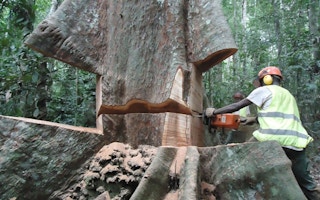The certification organisation Forest Stewardship Council (FSC) took a step toward allowing timber companies that have cut down forests since 1994 to apply for the organisation’s stamp of approval.
Since its inception 23 years ago, the FSC has refused to certify any company that has deforested areas in order to convert them to timber plantations.
While the passage of Motion 7 at the General Assembly meeting in Vancouver, British Columbia, on October 13 does not change this, its approval by the organisation’s membership—comprising private companies, individuals and conservation NGOs—indicates that the council’s requirements could change.
Proponents argue that the measure would increase access to certification in developing economies. But some question how effective certification actually is and say that changing the cutoff date could increase the destruction of forests.
“I think it’s becoming more and more apparent for FSC that this 1994 rule is becoming like a blockage,” said Aditya Bayunanda of WWF Indonesia. “The FSC should be open to all.”
“
It ought to be the final nail in the coffin of FSC’s credibility.
Simon Counsell, executive director, Rainforest Foundation UK
Bayunanda proposed the motion, which allows discussions about changing this regulation to continue.
In his view, a rule change would allow the participation of companies from developing countries, whose economies were just getting going around the time the FSC was created.
“It wasn’t by design,” Bayunanda said in an interview. “It was just like that.”
Allowing these companies to earn certification would require them to adhere to the FSC’s standards regarding biodiversity conservation and the protection of human rights, Bayunanda said, and he cautioned that just because certification would be possible doesn’t mean it would be easy.
At this point, the motion does not specify what FSC would require of companies that had converted forests after 1994 to attain certification, but Bayunanda said that they would likely have to “restore or conserve equivalent” areas of land to what they had cleared.
Additionally, they would need to compensate the communities for “the social damage” that the land conversion caused. He said both would be “game-changing.”
“Now they have to be a leader in restoration and conservation,” Bayunanda added.
Rainforest Action Network’s Bill Barclay said that any change “requires a very high-bar set of compensation standards, indicators and procedures if the 1994 rule is ever to be replaced and approved by all chambers of the FSC General Assembly.”
That would mean a comprehensive assessment of how the forest clearing hurt not just the environment but also communities, Barclay added. Rainforest Action Network is an FSC member.
A new rule with those kinds of stringent requirements could result in the “[restoration] and conservation of millions of hectares of forest and social restitution for communities,” said Grant Rosoman, a global forests solutions senior advisor with Greenpeace, in an email. Greenpeace is also a member of FSC.
But others involved in rainforest conservation see moving the cutoff date up to the present as capitulating to the desires of the timber industry and plantation companies.
Simon Counsell, executive director of the Rainforest Foundation UK, called the passage of the motion “a clear and major turning point for the FSC” because it is considering allowing “FSC certification of wood products that are from areas of forest that have been destroyed, not managed sustainably.”
“It ought to be the final nail in the coffin of FSC’s credibility,” Counsell added in an email.
Chris Lang of the website REDD-Monitor expressed concerns about what a rule change might mean for people directly affected by forest conversion.
“The advantages to the pulp and paper industry are clear, but it’s extremely difficult to imagine how this decision helps indigenous peoples and local communities who are struggling against the spread of monoculture tree plantations on their lands,” Lang said.
But Greenpeace’s Rosoman said that the support for Motion 7 came largely not from plantation companies, but from “other stakeholders.” He said that some companies may be against a change to the 1994 rule because it serves as “a trade protection measure,” keeping competitors from receiving the certification.
Still, Lang said that FSC’s goal seems to be increasing the percentage of timber companies that are certified, not the sustainability of the industry.
“With Motion 7, FSC will no doubt be able to certify even more destructive industrial tree plantations, and therefore increase the percentage of certified industrial timber,” he said. “But the chances of Motion 7 leading to meaningful changes in the pulp and paper sector are approximately zero.”
“That highlights a key question about FSC certification: whether FSC-certified operations are in fact sustainable,” said Cyril Kormos, vice president of policy at WILD Foundation, in an email. “There is very strong evidence that even certified logging operations are not sustainable – and that making them truly sustainable would require massive subsidies.
“FSC certification is obviously better than conventional logging – there is little question about that,” Kormos added. “But that doesn’t mean that it is good enough, let alone truly sustainable.”
This story was published with permission from Mongabay.com








